Learn Spanish in Spain
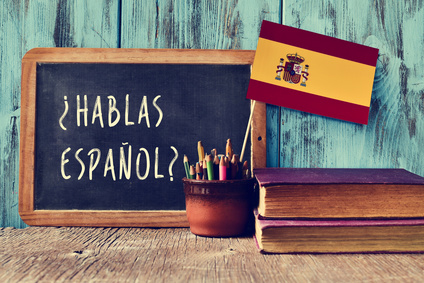
Located on the Iberian Peninsula at the south-western tip of Europe, Spain is a popular tourist destination. The former world power with numerous colonies went through difficult times and changes in the 20th century. The introduction of democracy in 1975 and its accession to the European Union in 1986 gave the country a new lease of life and turned it into a diverse, colorful and sunny tourist destination.
The Kingdom of Spain includes the popular Balearic Islands in the Mediterranean and the Canary Islands in the Atlantic. What few people know: Two North African cities on the Mediterranean coast - Ceuta and Melilla - also belong to Spain, along with some islands near the Moroccan mainland. The town of Llívia in the French Pyrenees is also an exclave of Spain. In addition, Gibraltar at the southernmost tip of Spain is British territory.
Anyone planning a language study trip to Spain should know that the 43.5 million Spaniards speak four different languages. 74% of Spain's inhabitants speak Castilian (Castellano), which we generally refer to as Spanish today. Catalan (Catalàn) is the language of 17% of the Spanish population, Galician (Gallego) is spoken by 7% of the Spanish population and Basque (Vasco) is spoken by just 2% of Spaniards in their everyday lives.
The Spanish culture ensures that a language study trip to learn Spanish is full of unique experiences. Spaniards celebrate the festivals as they fall - that's what they are known for. Some of the most famous and flashy festivals are "La Tomatina" - the tomato battle - and the "Fiesta de San Fermin" where a multitude of bulls thunder through the streets. Spain also has a lot to offer in other respects: Buildings and architecture steeped in history, bullfights, culinary delights, football and numerous museums attract tourists and Spanish students from all over the world for a language study trip.
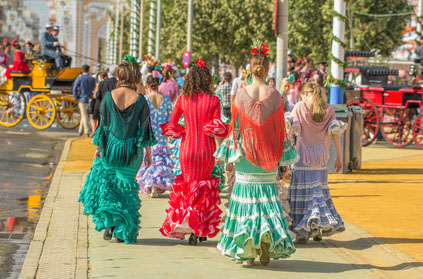
The most popular destinations in Spain
Spain is divided into 17 autonomous communities (comunidades autónomas). There are numerous exciting and thrilling destinations for a language course in Spain. Some are located inland, others on the Mediterranean coast. Vibrant nightlife, expansive nature, large cities, parks, vineyards, beaches, nature, historic cultural sites, picturesque buildings, art, tasty tapas; a language study trip to Spain offers something for everyone...
The cities in Spain could hardly be more different and each place has its own unique charm. Before you decide where in Spain you would like to plan your language study trip, look for information about the individual cities. If you want to see more than one city in Spain, you also have the option of booking several Spanish courses in different locations and traveling the country in between. The diversity of Spain makes this an ideal option for a language study trip.
- MadridSpain's capital, is considered a mecca for culture vultures. Behind its unglamorous façade, the city hides a varied and fascinating world of culture and art with its numerous museums and galleries. The bullring, extensive green spaces, the weekly flea market on El Rastro and the lively nightlife make the city a varied backdrop for a language study trip to learn Spanish.
- Barcelonais probably the most popular and most visited Spanish destination. The dynamic and vibrant city is also very popular as a destination for language trips. The many successes of FC Barcelona have made football Spain's national sport and the third largest football stadium in the world, Camp Nou in Barcelona, attracts thousands of visitors every day. The energetic city offers visitors a multitude of possibilities: La Rambla, Plaça de Sant Josep Oriol and Plaça Reial are considered the focal point of the energetic city with their numerous bars, boutiques and cafés. The impressive Gothic cathedral is the venue for the Sardana - a Catalan dance performance - every Sunday. A language study trip to Barcelona guarantees action, long nights and unforgettable impressions.
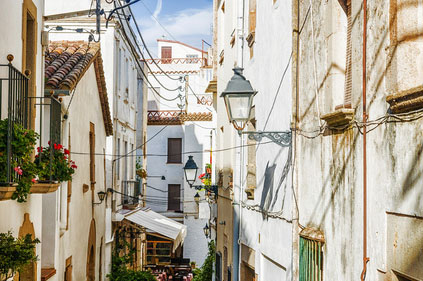
- Toledois one of the most important centers of Spanish history and still exudes a medieval charm to this day. For those interested in culture, the city is the perfect place for a language study trip in Spain. The Alcàzar fortress, which towers over the city, was the focal point of military confrontations for centuries. The two famous synagogues as well as the cathedral with its ornate architecture, archaeological finds of a basilica from the fourth century and numerous other sights form the city's valuable cultural treasure. Art lovers planning a language study trip to Spain should definitely enquire about language school offers in this city.
- Granadais the site of one of the most important witnesses to Moorish culture in Spain: El Alhambra. Built in the eleventh century, visitors can still recognize the splendour of Islamic culture almost a thousand years ago. Those who like trekking will appreciate this city as a place to stay during their language study trip in Spain. The nearby Sierra Nevada mountain range invites you to hike in the beautiful Andalusian countryside. The "gypsy caves" of Sacromonte in the north of Granada and various cultural and architectural sights in the city itself make it a popular destination for language travelers.
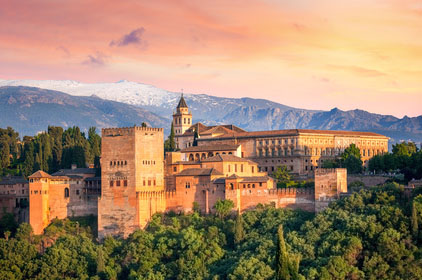
- Sevilleis the mecca of flamenco and an important university center. Many students live here - so the city is perfect if young people are planning a language study trip to Spain. Seville offers its inhabitants a varied living environment: numerous parks and green spaces, Moorish memorials, bullfights and the Archivo de Indias with its millions and millions of documents from the many centuries of colonialism in America.
- San Sebastiánimpresses with its captivating nature: beautiful sandy beaches and Monte Urgull, from whose summit you can enjoy a fantastic view. Water rats and beach nymphs will get their money's worth during a language study trip here. The wealthy city is a popular destination for well-heeled locals and impresses not least with the cheerful ease of its inhabitants.
- Also on theBalearic IslandsSpanish courses are offered. The islands of Mallorca, Menorca, Ibiza and Formentera are not only known for their legendary Ballermann parties. Breathtaking nature, olive and fruit plantations and small fishing villages exude Spanish charm. If you don't want to miss out on partying and beautiful days by the sea during your language study trip in Spain, the Balearic Islands are definitely the right place for a language study trip.
- TheCanary Islandsin the Atlantic are known as a vacation and beach holiday destination. However, the islands also offer exciting opportunities for language study trips to learn Spanish! If you prefer hot temperatures and long for sunny days during your language study trip, you'll even find the right Spanish school here in the winter months.

Arrival
Spain is not very far from Switzerland. You can cross the border from France to Spain by car from German-speaking Switzerland in just eight to nine hours. If you want to travel to the Balearic Islands by car, you can book a ferry to Mallorca, Ibiza, Menorca or Formentera in Barcelona or Valencia. There are also ferries from one island to another. So if you want to learn Spanish and are planning a language study trip in Spain, you can make the journey in the comfort of your car. This is also very practical during your language study trip as it allows you to explore the surrounding area more quickly and independently. However, a much more frequently chosen means of travel is still the plane. Depending on the destination, Spain can be reached by air from Switzerland in just under two to three hours. The most popular flight destinations are Barcelona, Madrid and Malaga.
Weather, climate and temperatures
Spain does not have a uniform climate, there are different climate zones. Therefore, think in advance about the time of year and where you book your language study trip to Spain. Northern Spain has a temperate and relatively stable climate with average temperatures of 25°C in summer and 10°C in winter. In the higher mountainous regions, summers are cool and short and the winter months are cold. In the central part of Spain, the climate along the coast is oceanic-continental and balanced, with warm summers of around 30°C and mild winters of around 7°C. In the interior, summer temperatures of around 30°C are recorded, with an average of around 7°C in winter. Southern Spain has a subtropical climate with very dry, hot and long summer months, often well above 30°C. In the coldest winter months, Andalusian thermometers usually show pleasant temperatures of around 17°C. The Canary Islands in the Atlantic Ocean have a subtropical climate with hot summer temperatures of up to 50°C! Even at night, the temperature display never drops below 35°C...
Language schools in Spain
Numerous language schools offer a wide variety of courses. The following types of courses are very popular for language study trips in Spain:
- Customized Spanish course for individuals or very small groups. Such courses can be easily combined with travel and tourist activities.
- Small group courses for up to 3 students. Fast Spanish learning is guaranteed here.
- Half-day courses leave plenty of time to discover a city and region.
- Intensive courses with around 25-30 lessons per week lasting one to three weeks. Intensive learning enables rapid learning success. Intensive courses are ideal for short language trips during the vacations.
- Courses for employees in the tourism industry. Industry-specific courses increase career opportunities and possibilities thanks to a sound knowledge of Spanish in the tourism, hotel and catering sectors.
- Courses for business people in Business Spanish. Participants learn how to conduct business meetings and contract negotiations competently in Spanish.
- Preparation courses for Spanish diplomas such as DELE, TELC.
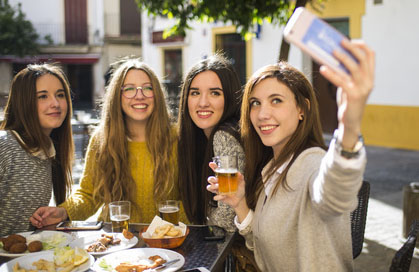
Entry requirements in Spain
Swiss citizens require a valid identity card or passport to enter Spain. Minors entering Spain alone must carry a valid identity document as well as written permission from their parents.
Safety and travel advice
Spain is generally considered a stable country. Nevertheless, there is a risk of demonstrations, especially in the major cities. In rare cases, these can lead to riots. Tourists should stay away from such situations and follow the instructions of the local authorities. Recent terrorist attacks have led to the Spanish authorities explicitly pointing out that there is a risk of terrorist attacks. Theft in Spain occurs frequently and predominantly in crowded places such as promenades, busy alleys and streets, bars, restaurants, the metro or the beach. Travelers should therefore take precautions in this regard.
Costs
The cost of a Spanish course in Spain varies from city to city and depending on the school. In most cases, courses are booked and charged on a weekly basis. The longer the language course in Spain lasts, the lower the course price per week. Preparation courses for Spanish diplomas usually last two to three weeks and cannot be extended or customized. An intensive or full-day course costs between 150 and 300 francs per week. Half-day courses and evening courses are correspondingly cheaper. Individual lessons are usually charged separately and cost around CHF 40 per unit on average.

In addition to the course costs, accommodation and meals during the language study trip in Spain must also be taken into account. The cheapest accommodation option is a shared flat or a host family. Some schools also offer inexpensive shared rooms that are shared with other language students. The outward and return journey, excursions, transportation, sports activities, etc. are also easier on the wallet.
